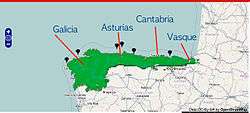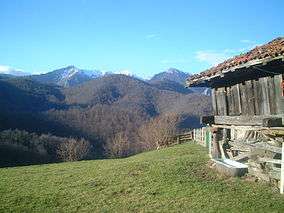Green Spain


Green Spain (direct translation into English of the Spanish España Verde) is the name given to the Spanish northern maritime façade exposed to the Atlantic Ocean in Galicia, which also runs along the coastal strip lying north of the Cantabrian and Basque mountains, along the Bay of Biscay. This land strip includes Asturias, Cantabria, and the northern half of the Basque Country and Navarre all the way from Galicia through the French border.
Climate and landscape
It is called green because its wet and temperate oceanic climate helps lush pastures and forests thrive, providing a landscape similar to that of Ireland, Great Britain, and the west coast of France.
The climate and landscape are determined by the Atlantic Ocean winds whose moisture gets trapped by the mountains circumventing the Spanish Atlantic façade.
Because of the Foehn effect, the southern slopes fall inside the rain shadow zone and so Green Spain contrasts starkly with the Spanish drier central plateau. Conversely, in those brief episodes when the southwestern winds blow through the mountains (especially during October–November[1]), the effect reverses, the northern coast gets inside the Foehn winds and is dry and much warmer than the inner plateau, where rain is present.
The average precipitation is about 1,200 mm, higher than in most areas in inland central Europe, and wetter than almost anywhere in Spain, a country generally considered dry (the main exception to this northernly rainfall trend is the Sierra de Grazalema, in the southern province of Cadiz, with mountains that block the Atlantic moisture-carrying winds and which is, indeed, the most rainy place in Spain). Asturias has an average summer temperature of 20-22C, being one of the mildest climates in Europe.
Most of the rain comes from the Atlantic through Galicia, the western part of Green Spain. Depending on the latitude of entry, this wet air can drop to the south, or more likely stay and run through the north stretch of land, pushed north by the Cantabrian mountains.
Native species
The main native tree species of this biome are beeches and oaks. In the second half of the 20th century, in some areas (especially in coastal areas), native forests were replaced by plantations of eucalyptus and Monterey Pines for its commercial exploitation in the paper industry.
The Pyrenees, which sometimes are considered in the same geologic system as the Cantabrian Mountains, were once included in Green Spain, even though the rainfall there has different patterns and the general landscape is more alpine rather than genuinely oceanic.
See also
Image gallery
-

The Picos de Europa.
-

Traditional Hórreo in Asturias.
-

Basque coast.
-
Coast of Cantabria.
-

Coast of Galicia.
-

Coast of Asturias.
External links
- Green Spain Green Spain's non official site.
- Visit Asturias A guide to Spain's Asturias region in English.
- Weather explained in Green Spain Asturias How is the weather in Green Spain in English.
References
- ↑ http://www.euskalmet.euskadi.net/s07-5921/es/contenidos/informacion/ana_viento/es_7279/es_viento.html from Euskalmet, Basque Meteorology Agency (in Spanish)